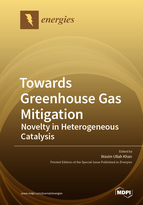Towards Greenhouse Gas Mitigation: Novelty in Heterogeneous Catalysis
A special issue of Energies (ISSN 1996-1073). This special issue belongs to the section "B: Energy and Environment".
Deadline for manuscript submissions: closed (31 March 2022) | Viewed by 14742
Special Issue Editor
Interests: heterogeneous catalysis; metal nanoclusters; catalyst development for CO oxidation; CO reduction towards higher alcohol synthesis
Special Issue Information
Dear Colleagues,
Climate change, a consequence of global warming, is a global issue resulting due to greenhouse gas (GHG) emissions. The main GHGs of concern are carbon dioxide (CO2), methane and nitrogen oxide. Scientists have utilized technologies in recent decades to mitigate GHGs. Among proposed technological solutions, catalysis—and in particular heterogeneous catalysis—has played a vital role in the abatement of GHGs.
One of the strategies to combat methane emissions is combustion, and catalytic combustion offers economic benefits due to the fact that the lower methane concentration in combustion emissions is less harmful than by-products such as formaldehyde. Nanotechnological advancement in heterogeneous catalysis for combustion has significantly reformed the process. The catalytic conversion of carbon dioxide is carried out via different routes, hence suggesting economic development of energy-efficient catalytic CO2 conversion to useful products. Some of the well-known catalytic routes to convert methane and CO2 include steam methane reforming, dry reforming of methane, partial oxidation of methane, methane decomposition, reverse water gas shift, CO2 hydrogenation to methanol, and CO2 hydrogenation to higher alcohols.
The investigation of metal/metal oxide nanoparticles anchored over oxide support in heterogeneous catalysis is significantly important for understanding the nature and extent of the metal–support interaction which affects the catalytic activity and product selectivity. The preparation of heterogeneous catalyst involves different elevated temperature steps including oxidation and reduction which influence the morphology of the catalyst. The metal–support interaction also causes morphological changes like alloy formation, sintering of metal particles, interdiffusion, and encapsulation. Therefore, the preparation steps need to be optimized to obtain well-dispersed metal nanoparticles anchored onto the oxide support. The recent developments in spectroscopic and microscopic characterization techniques as well as density functional theory have facilitated scientists in predicting the performance of the catalysts and proposing hypotheses before the reactions. Later, the suggested hypotheses are validated by characterizing the catalysts after the reactions.
Considering the above-mentioned developments in heterogeneous catalysis for GHG abatement, this Special Issue is mainly focused on the novel advancements in heterogeneous catalysis for mitigation of GHGs. Potential topics include but are not limited to the following: heterogeneous catalysts for steam methane reforming, dry methane reforming, partial oxidation of methane, methane decomposition, reverse water–gas shift, CO2 hydrogenation to methanol, and CO2 hydrogenation to higher alcohols.
Dr. Wasim Khan
Guest Editor
Manuscript Submission Information
Manuscripts should be submitted online at www.mdpi.com by registering and logging in to this website. Once you are registered, click here to go to the submission form. Manuscripts can be submitted until the deadline. All submissions that pass pre-check are peer-reviewed. Accepted papers will be published continuously in the journal (as soon as accepted) and will be listed together on the special issue website. Research articles, review articles as well as short communications are invited. For planned papers, a title and short abstract (about 100 words) can be sent to the Editorial Office for announcement on this website.
Submitted manuscripts should not have been published previously, nor be under consideration for publication elsewhere (except conference proceedings papers). All manuscripts are thoroughly refereed through a single-blind peer-review process. A guide for authors and other relevant information for submission of manuscripts is available on the Instructions for Authors page. Energies is an international peer-reviewed open access semimonthly journal published by MDPI.
Please visit the Instructions for Authors page before submitting a manuscript. The Article Processing Charge (APC) for publication in this open access journal is 2600 CHF (Swiss Francs). Submitted papers should be well formatted and use good English. Authors may use MDPI's English editing service prior to publication or during author revisions.
Keywords
- Methane
- Carbon dioxide
- Hydrogen
- Metal–support interaction
- Adsorbed oxygen species
- Acidity
- Basicity
- Carbon deposition
- Carbon nanotubes
- Catalyst deactivation






